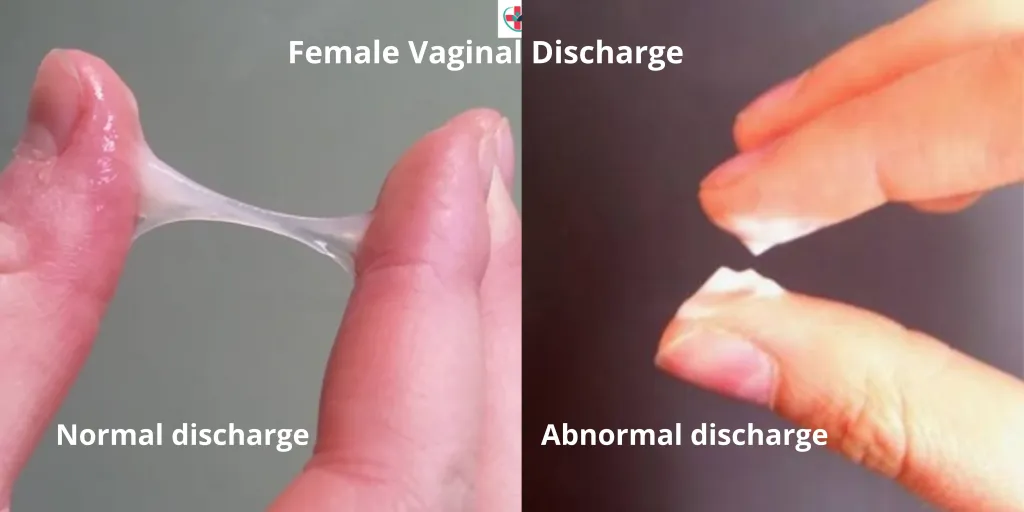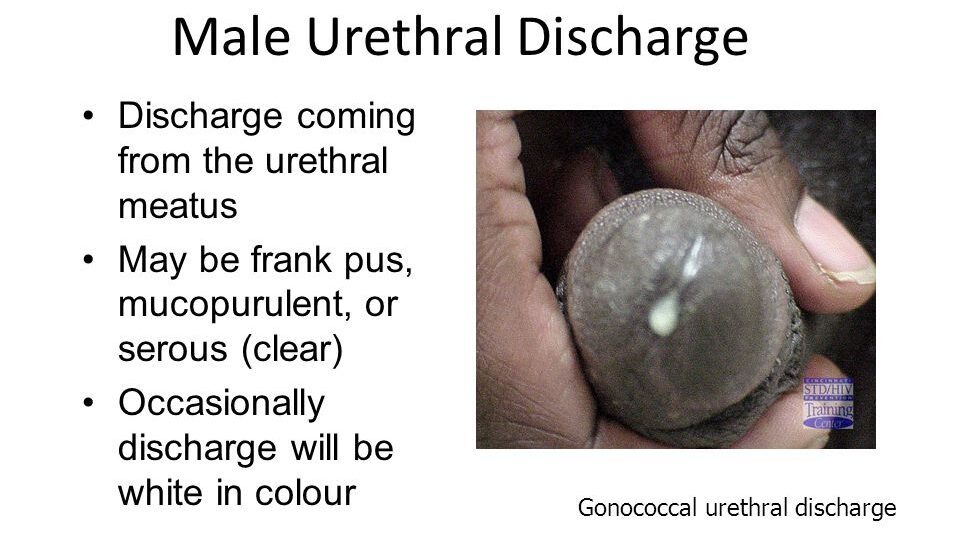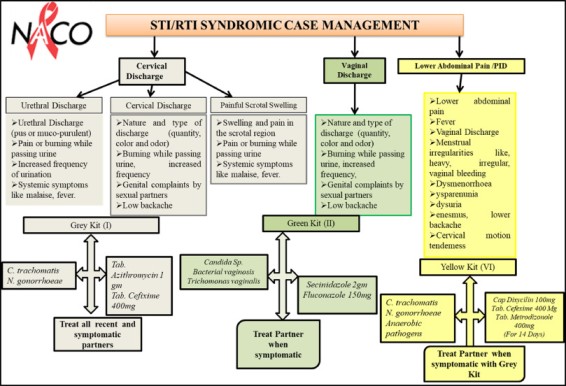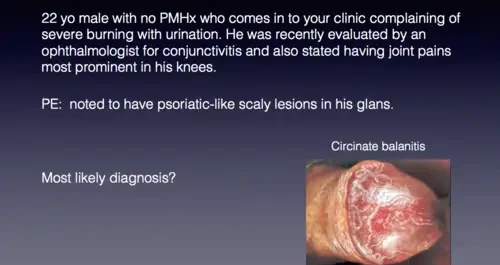cOMMUNITY dAY 1 qUIZ
cOMMUNITY dAY 1 qUIZ Read More »
Eczema, also known as atopic dermatitis, or atopic eczema, is a dermatologic problem where patches of skin become inflamed, itchy, red, cracked, and rough. Blisters may sometimes occur.
It is commonly seen in children. It is a relapsing skin problem that is manifested as pruritus, accompanied with swelling, redness, and dryness of the skin. Flaking, cracking, oozing, blistering or bleeding may occur as a result of excessive scratching of the skin.
Several factors are linked with this disease such as genetic mutation, and family history. Eczema cannot be cured, but it is not contagious. This is usually associated with allergy.
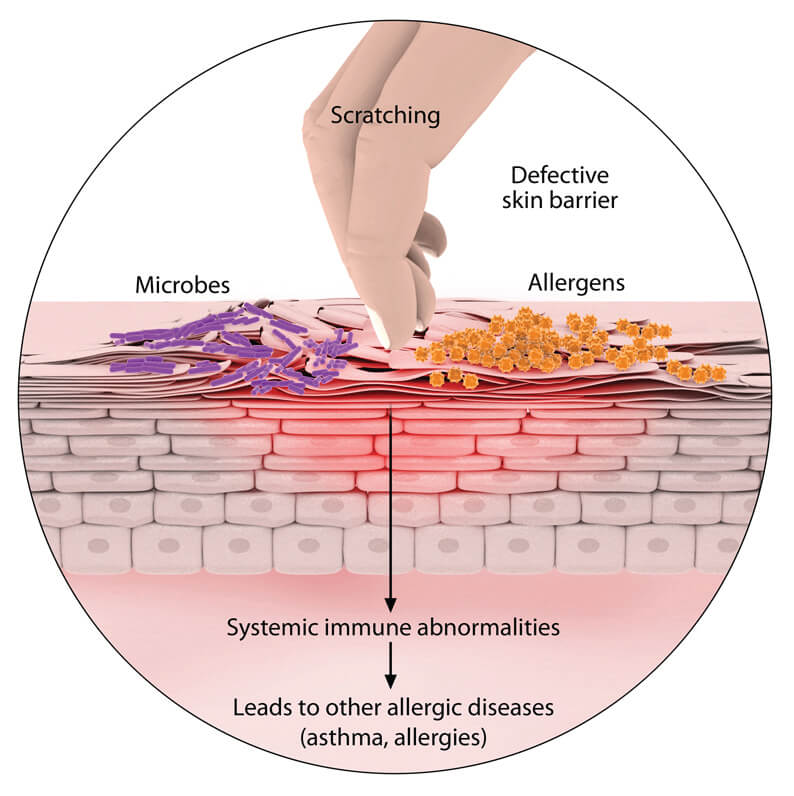
Causes of Eczema
The specific cause of eczema remains unknown, but it is believed to develop due to a combination of genetic and environmental factors.
Genetic Factors:
Environmental Factors:
Dietary Factors:
Other Factors:
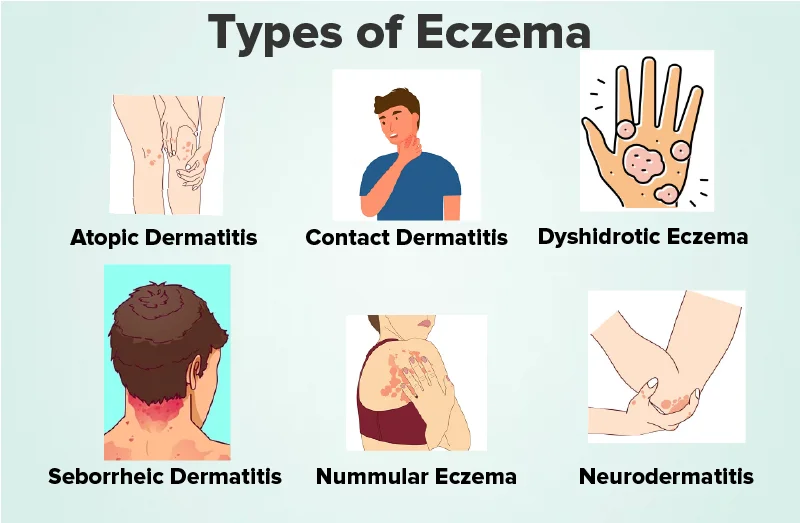
The National Eczema Association has categorized eczema into various types.
Table 1. More Common Types of Eczema.
Classification | Description |
Atopic eczema | Presented as xerosis and pruritus. |
Contact dermatitis | Skin lesions attributed to any allergens or irritants. |
Seborrhoeic dermatitis | Papulosquamous dermatologic disease with greasy scales on the scalp |
Table 2. Lesser Common Types of Eczema.
Classification | Description |
Dyshidrosis (Dyshidrotic Eczema/ Housewife’s Eczema) | Presents as pruritic vesicles with thickening and cracks on palms, soles, and lateral borders of fingers and toes. |
Nummular Dermatitis (Discoid Eczema) | Well-demarcated round, oozing lesions mainly on lower extremities with an unknown etiology. |
Stasis Dermatitis (Varicose eczema/Venous eczema) | Commonly found in ankles of individuals aged 50 and above with blood circulation problems; may lead to leg ulcers. |
Dermatitis herpetiformis | Often associated with celiac disease, featuring a symmetrical, pruritic rash on arms, knees, back, and thigh. |
Neurodermatitis(Lichen Simplex Chronicus) | Thickened, hyperpigmented, pruritic patch. |
Autoeczematization (Autosensitization) | Skin reaction to microorganisms, manifesting at a distance from the original site of infection. |
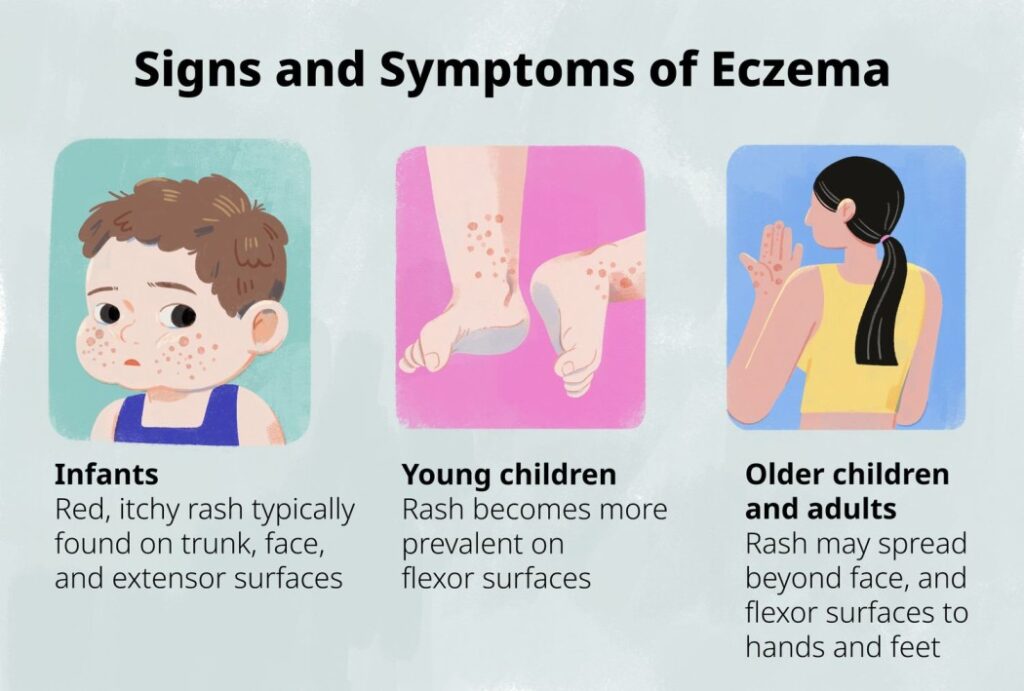
Infants (Under 2 Years Old):
Children (2 Years Until Puberty):
Adults:
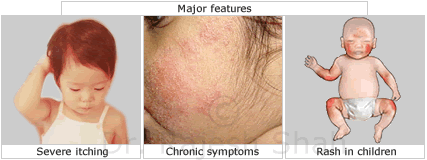
Assessment:
Skin Allergy Test:
Skin Biopsy:
Blood Tests – IgE Level:
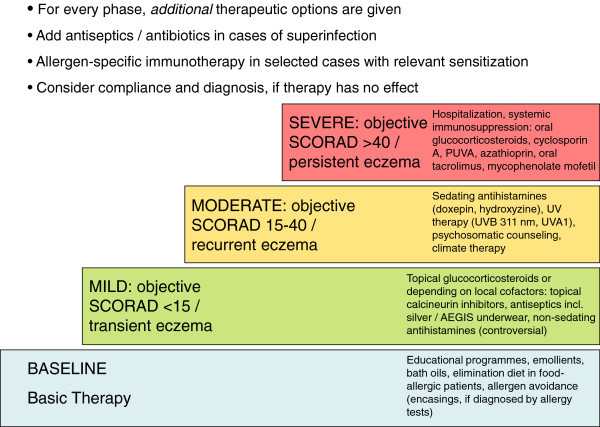
There is no cure for eczema. Treatment for the condition aims to heal the affected skin and prevent flare-ups of symptoms.
Treatment based on an individual’s age, symptoms, and current state of health.
For some people, eczema goes away over time. For others, it remains a lifelong condition.
Home Care
Medications
Other Therapies
Ongoing Care
Atopic dermatitis (AD) also known as atopic eczema is a common type of eczema that causes the skin to become itchy, dry, and cracked.
It results in itchy, red, swollen, and cracked skin. Clear fluid may come from the affected areas, which often thicken over time.
Other names include “infantile eczema“, “flexural eczema“, “prurigo Besnier“, “allergic eczema“, and “neurodermatitis“.
While the condition may occur at any age, it commonly starts in childhood with changing severity over the years. In children under one year of age much of the body may be affected.
As children get older , the back of the knees and front of the elbows are the most common areas affected.
In adults the hands and feet are the most commonly affected areas.
Scratching worsens symptoms and affected people have an increased risk of skin infections.
Many people with atopic dermatitis develop hay fever or asthma.
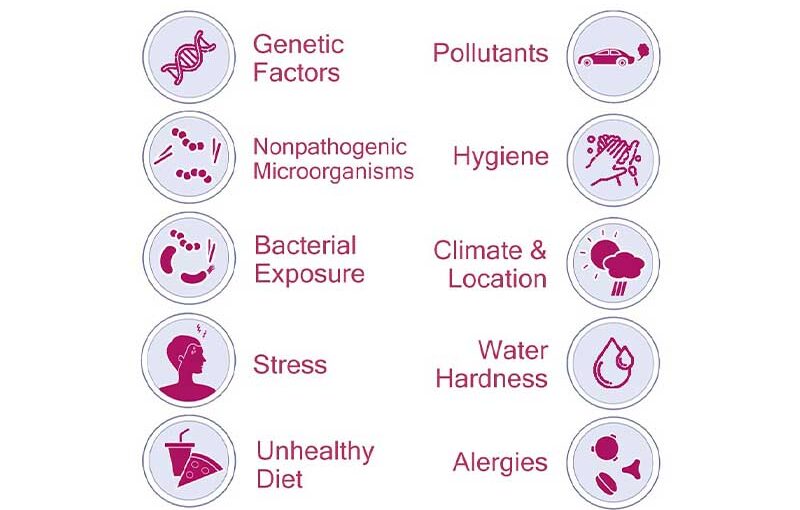
The exact cause of atopic dermatitis (AD) is unknown, but several factors are believed to contribute to its development, including genetics, immune system dysfunction, environmental exposures, and difficulties with the permeability of the skin.
Triggers of Atopic Dermatitis:
There are several factors that can trigger or worsen symptoms, including:
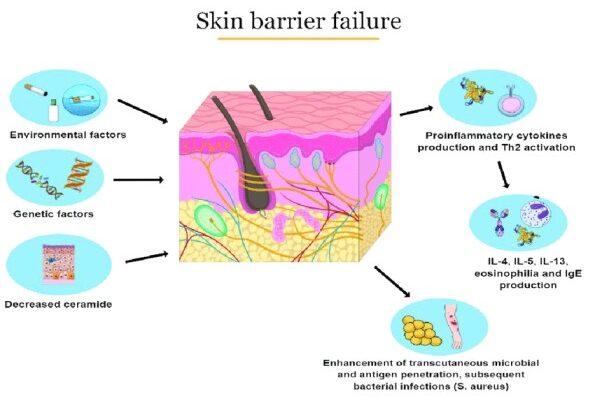
The disorder is not contagious. The pathophysiology may involve a mixture of type I and type IV -like hypersensitivity reactions.
After a Genetic Predisposition or any other predisposing factor, it leads to Skin Barrier Dysfunction hence a compromised skin barrier allowing irritants to penetrate more easily.
The immune system, especially the T-cells, responds exaggeratedly to these triggers leading to the release of inflammatory chemicals like histamines.
Inflammation occurs in the skin layers, causing redness, swelling, and itching. Scratching the itchy skin worsens the inflammation, leading to a cycle of itching and scratching leading to an imbalance of the skin’s normal flora like Staphylococcus aureus (S. aureus) with an overgrowth of S. aureus, further contributing to inflammation.
Chronic inflammation and persistent scratching can lead to a thinning of the skin layers which makes the skin more susceptible to infections and environmental damage.
Immune cells release cytokines like Interleukins, in particular, leading to even more inflammation. The combined effects of inflammation, scratching, and immune response result in characteristic eczematous lesions. These include red, dry, and scaly patches of skin. Triggers like allergens, stress, and environmental factors can exacerbate symptoms, leading to flare ups.
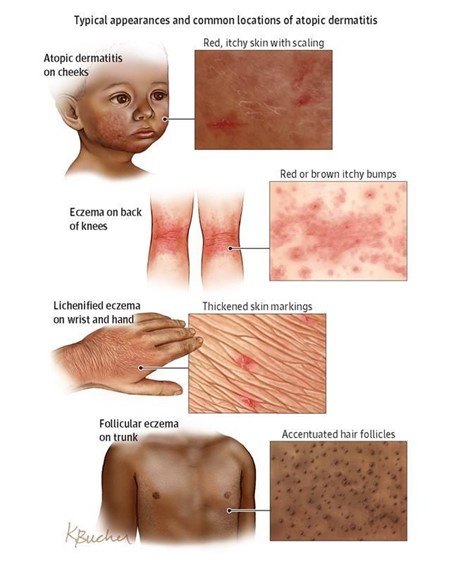
Additionally;
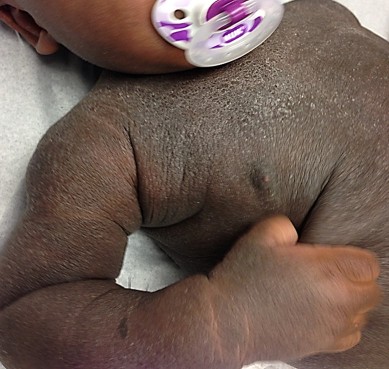
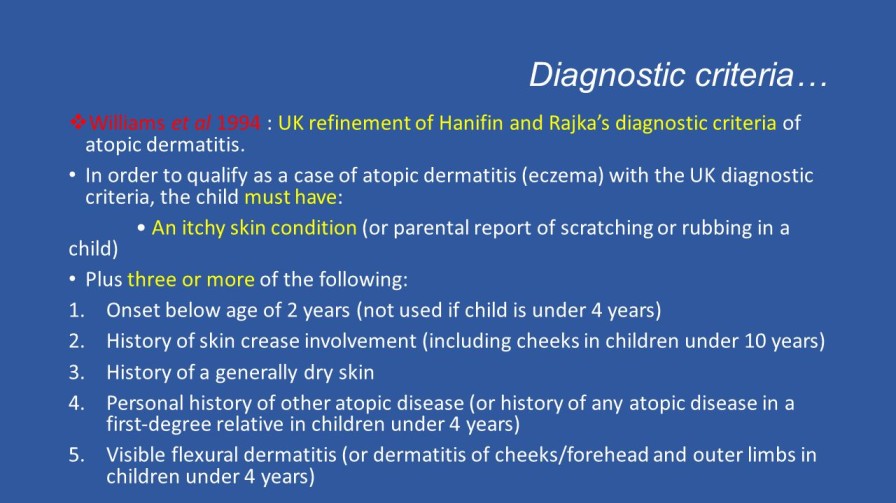
Atopic dermatitis is diagnosed clinically, meaning that it is diagnosed based on signs and symptoms alone, without special testing. However, several different forms of criteria developed for research have also been validated to aid in diagnosis.
Assessment: This involves a physical examination and a review of the patient’s medical history. The physical examination will focus on the skin, and the doctor will look for signs of atopic dermatitis, such as:
They will also ask about the patient’s family history of atopic dermatitis and other allergic conditions. A diagnostic criteria such as the UK Diagnostic Criteria can be used.
UK Diagnostic Criteria
The UK diagnostic criteria for atopic dermatitis are as follows:
Explanation of the Criteria:
Other Investigations
In some cases, the doctor may order other investigations to help confirm the diagnosis of atopic dermatitis. These investigations may include:
Differential Diagnosis
Atopic dermatitis can sometimes be confused with other skin conditions, such as:
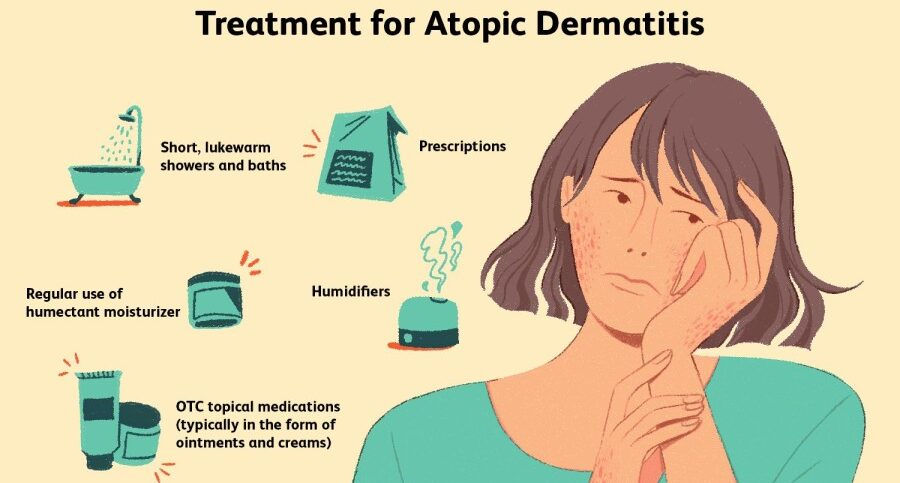
There is no known cure for atopic dermatitis (AD), but treatments can help to reduce the severity and frequency of flares. Treatment involves both preventive measures and medications.
Preventive Measures
Medications
Other Treatments

Inguinal buboes refer to localized swellings or enlarged lymph glands in the groin and femoral area.
They are often locally described as “grenades.”
Case Definition:
Inguinal Buboes Syndrome is characterized by the clinical manifestation of localized swellings or enlarged lymph glands in the groin and femoral area.
It is crucial to differentiate sexually transmitted causes, specifically LGV and chancroid, from non-sexually transmitted local and systemic infections, such as lower limb or gluteal region infections. Exclusion of these non-STI causes is essential for accurate diagnosis. Other causes inclide;
These swellings may present with pain and fluctuation and are commonly associated with Lymphogranuloma venereum (LGV) and chancroid. In the case of chancroid, an observable ulcer may accompany the buboes.
Examination and Differential Diagnosis to rule out Non-STI Causes:
Follow the Management Flow Chart:
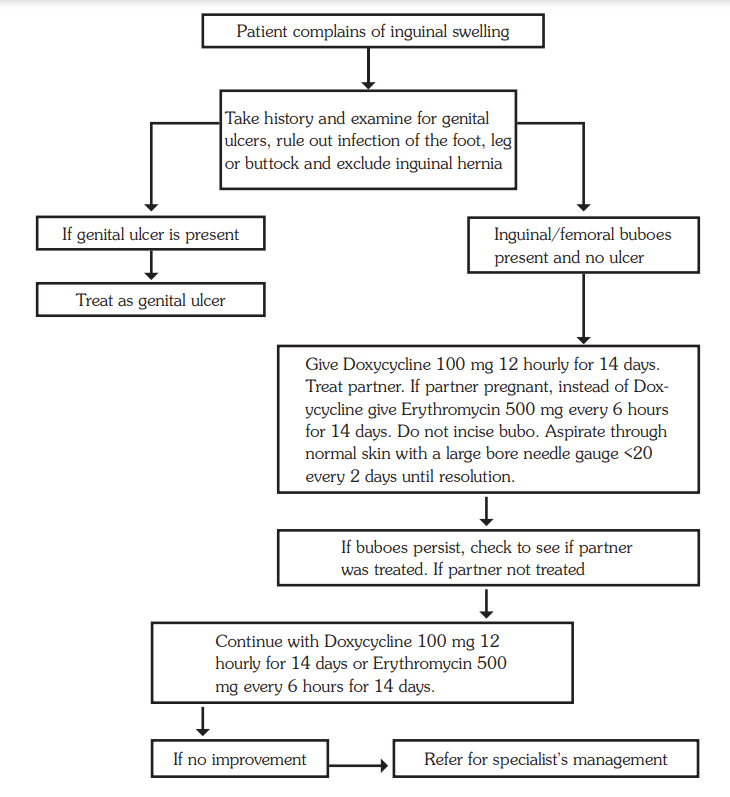
Pregnant Partner Consideration:
Aspiration of Fluctuant Swellings:
Address Underlying STI:
Monitoring and Follow-up:
Persistent Bubo Treatment:
Referral for Specialist Management:
Lower abdominal pain syndrome stands out as one of the most prevalent and serious STI syndromes among women, bearing significant reproductive health and socio-economic consequences.
Its presentation can be acute or chronic, posing diagnostic challenges due to numerous potential differential diagnoses.
Patients usually present with
Comprehensive evaluation involves assessing
Symptoms of lower abdominal pain and pain during sexual intercourse, coupled with examination findings such as vaginal discharge, lower abdominal tenderness on palpation, or a temperature > 38 degrees Celsius.
This syndrome strongly suggests pelvic inflammatory disease (PID), encompassing salpingitis and/or endometritis. Causative agents may include gonococcal, chlamydial, or anaerobic infections.
Referral for Surgical Emergencies:
Syndromic Antibiotic Treatment:
Intrauterine Contraceptive Devices (IUCD):
Comprehensive STI Case Management:
Inguinal Buboes Syndrome Read More »
Genital ulcer disease is a common syndrome affecting both men and women, characterized by single or multiple ulcers with different clinical manifestations.
Genital ulcer disease refers to breaks in the skin or mucosa and may present as ulcers, sores or vesicles.
Case Definition:
Non-vesicular Genital Ulcer: Ulcer on the penis, scrotum, or rectum in men, and on the labia, vagina, or rectum in women, with or without inguinal adenopathy. Vesicular ulcers involve the presence or history of vesicles.
The aetiology of this syndrome varies across geographical regions and can evolve over time, often presenting challenges due to mixed infections and the influence of HIV.
Multiple organisms can cause genital sores, commonly:
In men, genital ulcer disease occurring under the prepuce may present with a discharge in uncircumcised male patients, therefore, prepuce should be retracted and examined for ulcer lesions.
Female patients should have the labia separated and inspected, with speculum examination if necessary.
Mixed infections are common
Prompt treatment is important due to the increased risk of HIV transmission associated with genital ulcers.
Treatment strategies for both genders should align with the local epidemiology. In Uganda, the following approach is recommended:

Management Protocol for Genital Ulcer Syndrome:
Multiple Painful Blisters or Vesicles (Likely Herpes):
All Other Cases:
If Ulcer Persists Beyond 10 Days and Partner Was Treated:
If Ulcer Still Persists:
Important Notes:
Other Components of STI Case Management:
In addition to antimicrobial therapy, comprehensive STI case management includes:
Genital Ulcer Syndrome Read More »
Abnormal vaginal discharge is defined as discharge that is different from usual with respect to colour/odour/consistency (e.g. discoloured or purulent or malodorous).
While all women experience physiological vaginal discharge, concerns arise when it is perceived as abnormal. This syndrome is primarily attributed to endogenous vaginal infections, such as bacterial vaginosis and vaginal candidiasis, which are not exclusively sexually transmitted.
Candida vaginitis and bacterial vaginosis are NOT sexually transmitted diseases, even though sexual activity is a risk factor.
Case Definition:
Abnormal vaginal discharge (indicated by amount, colour, and odour) with or without lower abdominal pain or specific risk factors.
All women with vaginal discharge are treated for trichomoniasis, bacterial vaginosis, and candidiasis.
Increased Quantity of Discharge, Abnormal Color, and Odor:
Specific Discharge Characteristics for Different Infections:
Note: Microscopy and speculum examination are recommended to rule out early lesions of cervical carcinoma.
Women with vaginal discharge should be managed according to the flow chart. The flow chart differentiates between candidiasis and other vaginal discharges.

However, all women with abnormal vaginal discharge are treated for bacterial vaginosis and trichomoniasis and candidiasis. At the moment, it is not possible in this country to identify women with cervicitis, and all women with a non- curd like discharge should be treated for cervicitis.
Management Protocol for Abnormal Vaginal Discharge Syndrome:
Initial Assessment:
Lower Abdominal Tenderness with Sexual Activity:
Thick, Lumpy Discharge with Itching and Erythema/Excoriations (Likely Candida):
Abundant/Smelly Discharge (Possible Trichomonas or Vaginosis):
Purulent Discharge, High STD Risk, or Previous Ineffective Treatment:
Treat for Gonorrhea, Chlamydia, and Trichomonas:
Persistent Discharge or Dysuria Despite Partner Treatment:
Key management points include:
Treatment for Vaginal Infections:
Promotion of Syndromic Management Package:
Communication:
Evaluation and Referral:
Counsel and educate all clients on:
Abnormal Vaginal Discharge Syndrome Read More »
Urethral discharge syndrome is a prevalent sexually transmitted infection (STI) among men, marked by purulent urethral discharge, with or without dysuria.
The amount of discharge varies depending on the causative pathogens as well as prior antibiotic treatment.
Case Definition: Urethral discharge in men with or without dysuria.
All male patients with urethral discharge should be managed according to the syndromic chart.

Medicines
If partner is pregnant
Treatment Procedure:
Clinical Assessment:
Comprehensive Treatment:
Medication:
For Pregnant Partners:
Persistent Symptoms Despite Partner Treatment:
If Partners Were Not Treated Initially:
Comprehensive STD Case Management Package:
Continued Persistence of Discharge:
Counsel and educate all clients on:
Urethral Discharge Syndrome Read More »
Syndromic approach to STI management is a method of diagnosing and treating sexually transmitted infections (STIs) based on the patient’s clinical signs and symptoms, rather than laboratory confirmation.
Instead of targeting a specific pathogen, healthcare providers address the symptoms and syndromes associated with various STIs.
It is very useful in settings where laboratory testing is limited or unavailable.
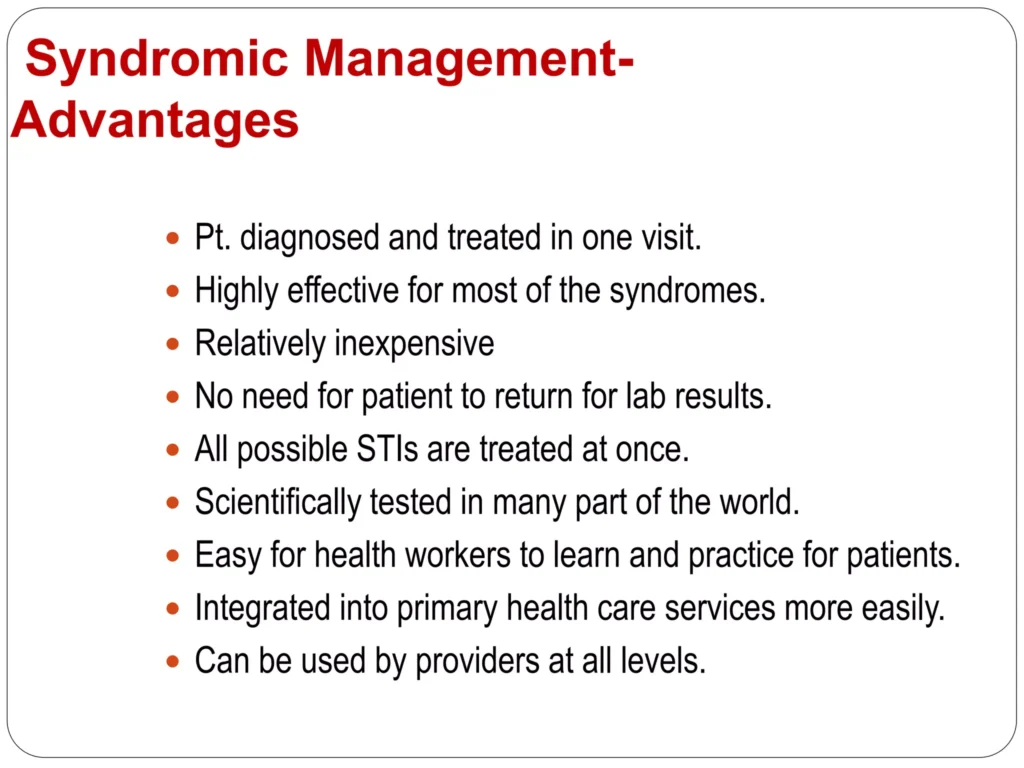
Improved Clinical Diagnosis:
Ease of Learning for Primary Health Care Workers:
Rapid diagnosis and treatment:
Same-Visit Treatment for Symptomatic Patients:
Cost-effectiveness:
Accessibility at Lower Health Units:
Preventive Partner Treatment:
Resource Efficiency:
Increased access to treatment:
Inadequate Care for Asymptomatic Individuals:
Overuse/Wastage of Medications:
Poor Predictive Value for Some Infections:
Risk of Antibiotic Resistance:
Challenges in Addressing Co-Infections:
Inefficacy for Viral Infections:
Potential for misdiagnosis:
Inadequate care for asymptomatic patients:
NOTE:
There are different approaches to STI diagnosis and management.
SO, In our current circumstances, the advantages of syndromic approach outweigh the disadvantages. A theoretical comparison of the cost effectiveness of the three approaches to diagnose 500 patients with genital ulcer, 500 patients with urethral discharge, and 500 with vaginal discharge found that the clinical and laboratory approach to diagnosis and management, each cost 2 -3 times as much as syndromic diagnosis. The cost of personnel and consequences of incorrect diagnosis accounted for most of the difference. By treating all STDs that cause a syndrome, syndromic diagnosis avoids many complications. Even in developed countries, many health care providers prefer to use the syndromic approach to avoid delay in treating their patients while waiting for laboratory results. |
Limited laboratory facilities:
Multiple organisms causing STI syndromes:
Delayed laboratory results:
Common occurrence of mixed infections:
Influence of self-medication and immunity on clinical picture:

STD Syndromic Treatment Flow Charts (Algorithms)
Diagnosis and treatment flow charts formalizing the Syndromic approach have been developed. They provide health workers with step by step instructions to diagnose and treat STDs with recommended drugs.
STD syndromic treatment flow charts, also known as algorithms, offer several advantages in the diagnosis and management of sexually transmitted infections (STIs):
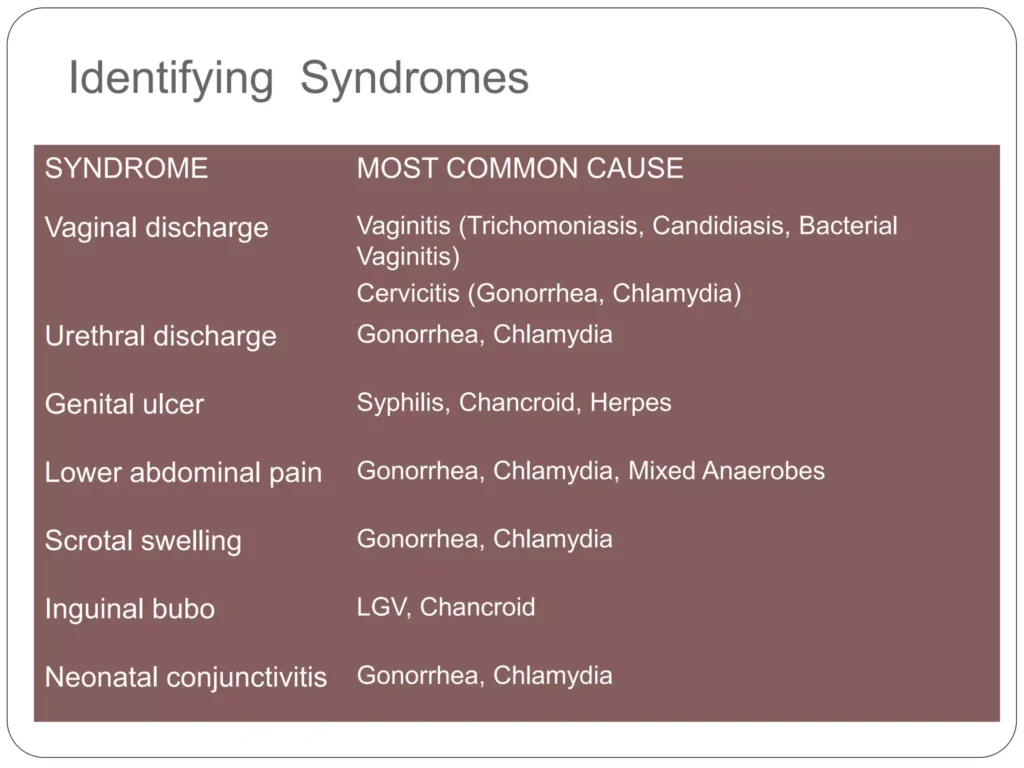
Commonest:
Others:
Syndromic management of STI Read More »
Chancroid is a sexually transmitted infection that causes painful open sores, or chancroids, to develop in the genital area. It can also often cause the lymph nodes in the groin to swell and become painful.
Incubation period: 2-5 days.

Chancroid is a sexually transmitted infection (STI) caused by the bacteria Haemophilus ducreyi.
Contracting chancroid primarily occurs through direct contact with the open sores of an infected individual. Additional risk factors include:
Timely medical intervention is crucial, usually involving a prescribed course of antibiotics. Recommended antibiotic therapies include:
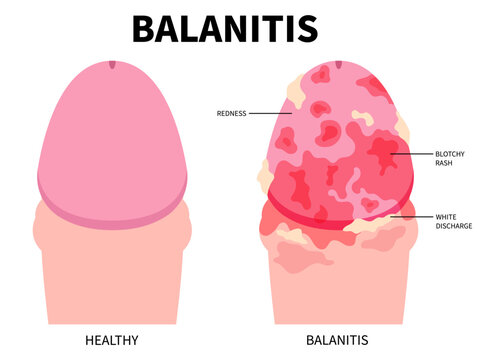
Balanitis refers to the inflammation of the glans penis, a condition that can be influenced by various factors, with Candida being a common causative agent, and Trichomonas, though rare, also implicated.
The primary causative agents for balanitis are fungal, with Candida being the commonest. In rare cases, Trichomonas may contribute to the inflammation.
Effective management of balanitis involves an approach aimed at addressing the underlying infection and promoting genital hygiene.
In cases where the condition persists despite initial management:

Syphilis is an STI caused by the spirochete known as Treponema Pallidum, with an incubation period of 9-90 days.
Primary stage:
Secondary stage:
Latent period:
Tertiary stage:
Swelling (gumma) on the skin, mucous membrane, and bones.
Ulceration of skin swellings resulting in chronic ulcers.
Spread to the cardiovascular system may lead to aortic aneurysm, aortic insufficiency, or coronary arteriosclerosis.
Spread to the nervous system may result in memory loss, confusion, mental disability, and general paralysis of the insane.
Joint degeneration, failing sight, and deafness may occur.
Education of clients:
Sexually transmitted diseases (STDs) are infectious conditions caused by one or more microorganisms primarily transmitted from one infected person to another during unprotected sexual intercourse.
The following table provides a summary of the most common STDs, categorizing them based on their etiological grouping and highlighting their main clinical features.
STD | Main Clinical Features | Causative Agents | Incubation Period |
Bacterial STIs | |||
Gonorrhoea | Pus discharge from urethra or cervix, dysuria, frequency | Neisseria Gonorrhoea | 2-6 days |
Syphilis | Primary chancre is painless, well-demarcated ulcer; other features depend on clinical stage | Treponema pallidum | 2-4 weeks |
Non-gonococcal urethritis/cervicitis | Thin, non-itchy discharge from cervix or urethra | Chlamydia, Mycoplasma hominis, and others | 7-14 days |
Lymphogranuloma venereum (LGV) | Swollen, painful inguinal glands (buboes) occasionally with an ulcer; may be bilateral | Chlamydia organism, LGV strains | 3-30 days |
Granuloma inguinale | Heaped-up (beefy) ulcer, usually painless, associated with inguinal lymph node swelling | Calymatobacteria granulomatis | 1-10 weeks |
Bacteria vaginosis | Thin discharge with a fishy smell from the vagina | Gardnerella vaginalis | May be endogenous |
Chancroid | Dirty, painless ulcer, usually underlying | Haemophilus ducreyi | 1-3 weeks |
Viral STIs | |||
Herpes Genitalis | Recurrent small, multiple painful ulcers beginning as vesicles | Herpes Simplex Virus | 2-7 days (initial infection) |
Hepatitis B virus infection (HBV) | Jaundice with inflammation of the liver | Hepatitis B virus | Varies |
HIV/AIDS | According to WHO clinical criteria for the case definition for AIDS | Human Immunodeficiency Virus | Months-10 years or more |
Venereal warts/HPV | Finger-like growths on the genitals | Human Papilloma Virus | Weeks-months |
Fungal STIs | |||
Genital candidiasis | White curd-like discharge coating vaginal walls, itchiness, soreness, excoriation, cuts | Candida Albicans | May be endogenous and recurrent |
Ringworm (fungal) | Patches of hypo/hyperpigmentation in the pubic area | Tinea Organisms | Varies |
Protozoal STI | |||
Trichomoniasis | Greenish, itchy discharge from the vagina with an offensive smell | Trichomonas vaginalis | Variable |
Other STIs | |||
Scabies | Vesicles containing mites in the pubic area | Sarcoptes scabiei | 30 days |
Pediculosis (vermin) | Presence of nits in pubic hair, itching in pubic area | Phthirus pubis (pubic lice) | 7 – 10 Days |
Risk factors contributing to the prevalence of STDs in Uganda encompass a range of influential elements. These include:
CHANCROID, BALANITIS & SYPHILIS Read More »
Gonorrhoea is a sexually transmitted infection caused by the Neisseria gonorrhoeae bacterium, which targets the mucous membranes of the reproductive tract.
In women, this includes the cervix, uterus, and fallopian tubes, while in both men and women, it affects the urethra. Additionally, Gonorrhea can impact other areas such as the mouth, throat, eyes, and rectum. Perinatal transmission from an infected mother to her child during delivery through the birth canal is also possible.
Incubation Period: 2 to 7 days
In Men:
In Women:
Untreated gonorrhoea can lead to severe permanent problems in both men and women, increasing the risk of acquiring HIV, hepatitis B and C.
In Women:
In Men:
In Neonates:
Note: In both sexes, the bacteria can enter the bloodstream, spreading throughout the body in approximately 2% of cases, causing fever, loss of appetite, arthritic pain, and potentially invading vital organs such as the heart, liver, and CNS.
Alternative Treatment:
Chlamydia is a common sexually transmitted infection caused by Chlamydia trachomatis, a gram-negative bacterium.
It stands as the most frequently reported sexually transmitted disease. Most people with chlamydia do not show symptoms.
It is spread through unprotected sexual intercourse, whether vaginal or oral, with an infected person.
In Women:
In Men:
Caused by Trichomonas vaginalis
Bacterial vaginosis, also known as vaginal bacteriosis, is the most common cause of vaginal infection for women of childbearing age.
It frequently develops after sexual intercourse with a new partner, and it is rare for a woman to have it if she has never had sexual intercourse.
Bacterial vaginosis (BV) also increases the risk of developing a sexually transmitted infection (STI). However, BV is not considered an STI.
Genital warts are a viral infection that develops in the genitals, perineum, and anus. In females, it rarely occurs in the vagina. They grow rapidly during pregnancy and regress in the puerperium. The infection may result in an offensive odour.
Based on the clinical findings of a soft chancre, a small painful ulcer that is irregular in shape.
Genital herpes presents as small, painful blisters on the vulva, perineum, vagina, and/or the penis or perineum in males, caused by the herpes simplex virus.
Incubation period: 2-21 days.
PID is an infection of the upper genital tract (uterus, fallopian tubes, ovaries, and peritoneum), commonly resulting from STDs (gonorrhoea, Chlamydia).
Sexually transmitted diseases (STDs) are infectious conditions caused by one or more microorganisms primarily transmitted from one infected person to another during unprotected sexual intercourse.
The following table provides a summary of the most common STDs, categorizing them based on their etiological grouping and highlighting their main clinical features.
STD | Main Clinical Features | Causative Agents | Incubation Period |
Bacterial STIs | |||
Gonorrhoea | Pus discharge from urethra or cervix, dysuria, frequency | Neisseria Gonorrhoea | 2-6 days |
Syphilis | Primary chancre is painless, well-demarcated ulcer; other features depend on clinical stage | Treponema pallidum | 2-4 weeks |
Non-gonococcal urethritis/cervicitis | Thin, non-itchy discharge from cervix or urethra | Chlamydia, Mycoplasma hominis, and others | 7-14 days |
Lymphogranuloma venereum (LGV) | Swollen, painful inguinal glands (buboes) occasionally with an ulcer; may be bilateral | Chlamydia organism, LGV strains | 3-30 days |
Granuloma inguinale | Heaped-up (beefy) ulcer, usually painless, associated with inguinal lymph node swelling | Calymatobacteria granulomatis | 1-10 weeks |
Bacteria vaginosis | Thin discharge with a fishy smell from the vagina | Gardnerella vaginalis | May be endogenous |
Chancroid | Dirty, painless ulcer, usually underlying | Haemophilus ducreyi | 1-3 weeks |
Viral STIs | |||
Herpes Genitalis | Recurrent small, multiple painful ulcers beginning as vesicles | Herpes Simplex Virus | 2-7 days (initial infection) |
Hepatitis B virus infection (HBV) | Jaundice with inflammation of the liver | Hepatitis B virus | Varies |
HIV/AIDS | According to WHO clinical criteria for the case definition for AIDS | Human Immunodeficiency Virus | Months-10 years or more |
Venereal warts/HPV | Finger-like growths on the genitals | Human Papilloma Virus | Weeks-months |
Fungal STIs | |||
Genital candidiasis | White curd-like discharge coating vaginal walls, itchiness, soreness, excoriation, cuts | Candida Albicans | May be endogenous and recurrent |
Ringworm (fungal) | Patches of hypo/hyperpigmentation in the pubic area | Tinea Organisms | Varies |
Protozoal STI | |||
Trichomoniasis | Greenish, itchy discharge from the vagina with an offensive smell | Trichomonas vaginalis | Variable |
Other STIs | |||
Scabies | Vesicles containing mites in the pubic area | Sarcoptes scabiei | 30 days |
Pediculosis (vermin) | Presence of nits in pubic hair, itching in pubic area | Phthirus pubis (pubic lice) | 7 – 10 Days |
Risk factors contributing to the prevalence of STDs in Uganda encompass a range of influential elements. These include:
Javascript not detected. Javascript required for this site to function. Please enable it in your browser settings and refresh this page.




